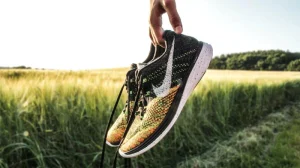Imagine this. Sunset on the beach, the sky is purple, the sand is soft and delicate, ready for your steps on it. You are standing there barefoot, all excited about your sand running experience. Take a deep breath, and start your run. You are going to feel every step like walking on the clouds. Your feet are sinking into it, and you feel fantastic.
Running on the sand makes your body burn more calories, which is excellent!
You consume more oxygen while running on the sand than on a hard surface.
And, of course, it is more natural to run barefoot.
But there are many pros and cons about is it better to run barefoot or with running shoes on your feet.
Running on the sand is different from running on a smooth and hard surface. It is a fantastic way to diversify your running routine and make it more enjoyable while avoiding injury risks.
So many kinesiologists are recommending switching sometimes running on concrete or tartan with running on a send.
Running on sand has a much different impact on the foot muscles, bones, and other parts of the legs and hips.
It is harder on tendons, joints, and knees when running on a hard surface.
By switching on the sand, you are putting less stress on the weight-bearing sensitive parts of your body(ankles, knees, and hips).
So, by making a small diversity in your everyday routine, you optimize your performance and reduce small and significant injuries.
So, let’s start with safety.
Does Running on Sand Hurt Your Feet?
Running by the beach sounds challenging, but we have to be aware of a few things in reality regarding safety:
There is always a risk of cutting your foot with some broken seashell when barefoot running.
Also, your skin is under direct sunlight, so you have to be careful and always wear a sun-protecting creme.
Your feet are in direct contact with sand, warm water, and microorganisms. So you could easily get some infection like fungi or bacteria.
If you feel some strange pain in your knees, ankles, or hip, you are not ready to run in the sand, which means it is not a good option for your muscle structure.
If you are wearing running shoes, you should also bring some lubricants, because there will always be some situation that could make you a blister or some minor scratch.
Be careful and stay hydrated.
Start with a small millage, and after, you can gradually increase your distance to achieve your ideal length.
It would help if you were careful when choosing your running time and avoided running between 10:00 a.m. and 04:00 p.m. when sand reflects the sun so that it can burn your feet.
Running early in the morning is best to avoid the crowd.

Is it Good to Run on the Beach Barefoot?
Running barefoot also has a bright side. So here are a few pros of running barefoot:
Legs, feet, and toes will get stronger. Running barefoot develops different muscle groups because it activates them entirely differently.
More prominent arches. Wearing running shoes and running barefoot affect differently on your foot arches. Because running barefoot is more natural than running with shoes, your foot arches get more shaped.
Toes are more active, and the nails are less injured because they have natural movement.
Chances of getting spraining an ankle are less common.
The feet are wider at the front of your feet than running shoes, impacting your balance.
The feet are warmer because of increased blood flow, so the circulation improves and reduces feelings of heavy legs.
Barefoot running is getting you fewer blisters.
Running barefoot exfoliates your skin on foot. That is why you have softer and firmer skin. The skin feels like strong and very soft leather.
Should You Run With Shoes in the Sand?
Running on the sand is a remarkable experience whether you run barefoot or wearing running shoes.
It is much different from running on a hard surface because it absorbs more energy and strength from your body while burning more calories.
That means running on sand is much more challenging because it needs additional effort to move forward.
But is it better to run in your shoes?
Wearing running shoes will provide your ankles with more stability than running barefoot.
It will take some time while your feet adjust new surface.
They will protect your feet from burning, cutting on broken seashells, or some rocks ejected when the tides are high.

Is it Good to Run on Soft Sand?
Dry and soft sand is a much more demanding surface for running, and it requires more experience.
It is also an unstable surface, but running on it helps your body improve your balance while increasing effort on muscles and ligaments.
A study published in the Journal of Sports Sciences found that the soft surface reduced muscle soreness and fatigue.
A small 2017 study published in the European Journal of Sport Science showed that women who ran on soft sand experienced minor muscle damage and inflammation than those who ran on grass(source)
So, is it better to run on the wet or the dry sand? It depends on your experience, goals, and the result you aim to achieve.
Wet Sand
When you try to run on dry or wet sand, you should always prepare yourself.
It is essential to give your body at least two weeks of the adaptation period, so your body can adjust to the new running routine.
In the beginning, you should be aware that you should increase your time, not your mileage. That means that you should go slower but gain distance.
Also, warming up reduces injuries because running on the sand and focusing on the posterior chain (glutes, hamstrings, calves) activated more on the sand, so you should always warm up before running.
It is an excellent opportunity to refresh yourself in the water after your workout.
Many experts say that for beginners is always better to start on the wet sand. The main difference between wet and dry sand is compactness and softness.
Wet sand is much more compact and gives your ankles better stability.
That is why running on wet sand requires much less effort, and it is less demanding for leg muscles.
The wet sand running routine is not to improve your speed.
It helps to naturally strengthen the muscles, improve your stability and energy, and improve your endurance.
An ideal time to run near the water is when the tides are low.
What Kind of Shoes to Wear Running on the Beach?
There are no specific running shoes for running on the beach. Most runners use their regular road running shoes or their light-weight trail shoes. If you intend to run exclusively on the beach for some time, it is best to buy more durable and firm shoes. If you have sensitive feet, wearing tall socks is the best practice while running on the beach.





